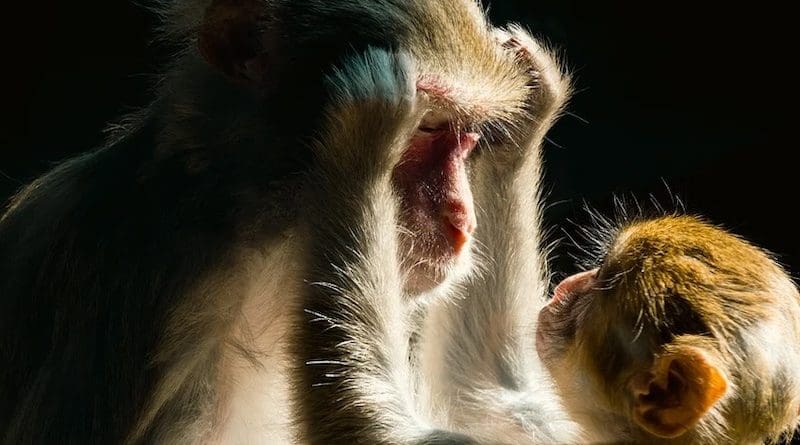Raising Hairless Primates – OpEd
By Amy Pollick
I remember the first time I observed my daughter pointing. We were at a neighborhood playgroup, a daily gathering of toddlers and their parents, and 12-month-old Tessa pointed at a painting of a koala on the wall. I marveled at her, almost yipping with joy. In the days and weeks that followed she pointed with growing frequency at things that interested her, and, more importantly, things she wanted to share with me. And every time she did this, I looked at her in astonishment. The other parents thought I was nuts.
Earlier in my life, I was a primatologist—I studied behavior and communication in capuchin monkeys, chimpanzees, and bonobos (the latter a relative of the chimpanzee, but a distinct species with very different behavioral characteristics). I eventually specialized in gestural and multimodal communication in great apes. Great apes have more cortical control over their hands than other primates, and they use their hands to gesture to one another. In addition to gestures, apes use facial expressions and vocalizations to communicate, and sometimes they use all three modalities simultaneously (as humans do)—hence the term “multimodal communication.”
One thing I always looked for while gathering my data was pointing; it was rare among the socially housed, outdoor-living chimps I studied, and the handful of times I observed it, it was a big deal. To be sure, chimps have other ways to signal to each other what they want, but pointing with their index fingers isn’t usually one of them. When I saw this very common behavior develop in my own child, my appreciation deepened for just how complex (and social) human cognition is.
Primatologists study our closest living relatives for a variety of reasons—to intrinsically understand more about their lives (diet, habitat, mating patterns, genetics), to understand how they interact with their environments, and to shed light on what our last common ancestor with the apes might have been like. One of the enduring mysteries of human evolution is how much of our behavior and cognition is uniquely human and how much can be found in living primate species. This was my research focus.
When I stared in amazement as my daughter pointed to the koala painting while looking at me, what the other parents didn’t know was that I was marveling at how often human toddlers point, and referentially point, at that—meaning children point to share attention, not just to obtain things. The distinction is known as declarative vs. imperative pointing—”Hey Mom, look at that cool thing over there!” as opposed to “Give me that piece of candy on the shelf.” Pointing is considered a hallmark of communication, language development, and joint attention (when one individual wants another to pay attention to the same thing she is looking at), and neurotypical toddlers do it all the time (the absence of pointing is a marker for autism).
In addition to my daughter Tessa, I have a son, Eli, who is two years younger than her. Like all siblings, they are obsessed with fairness (I don’t believe any parent who says their kids aren’t). If one kid gets a cookie that’s even a millimeter bigger than the other’s, all hell breaks loose. You can try all you want to justify to them why one cookie is bigger, but the kids aren’t having it. We tend to think this focus on fairness is uniquely human, but my lab colleague Sarah Brosnan and our PhD advisor Frans de Waal corrected this notion 20 years ago in a landmark study aptly named “Capuchins Reject Unequal Pay.” In this study, two brown capuchins (highly intelligent South American monkeys) worked side by side on a token exchange task. As a reward, each received a cucumber slice. When the monkeys received the same reward for the same work, all was peaceful. That peace was quickly disrupted when one received a grape (more desirable than the cucumber) and the other still got the cucumber. After being perfectly happy with a cucumber, once the monkey saw the other one’s grape, he lost it; he literally threw it out of his enclosure with what I freely admit is an anthropomorphized sense of indignance. Capuchins reject unequal pay indeed.
When I see my children argue over the fact that one’s backpack is taking up an inch more space on his side of the car than the other’s, I try to remember that this is evolutionarily ancient behavior, one that ensures that cooperation is beneficial to our species. Why do we care if someone gets more than we do, all other things being equal? In the long term, if we feel assured that everyone is putting in equal amounts of work for similar pay, we’re more willing to cooperate. I tell this to my kids, but for some reason, they don’t act like rational beings and bicker less. But when they figure out that cooperating nets them big payoffs (such as stepping on each other’s shoulders to reach the candy I thought I’d so cleverly hidden), they’re my shining examples of evolutionary continuity. I couldn’t be more proud.
Viewing my children through primatological glasses provides me with an ongoing perspective on raising them. When they have tantrums, argue over the last slice of cake, or try to get my attention through gestures, those glasses enable me to take a step back and recognize a broader purpose (I hope!) of their behavior. And this perspective also helps me feel another layer of connection. Remembering that we’re all one big primate family makes the wilds of human parenting a little more manageable—and fun.
- About the author: Amy Pollick received her PhD in animal behavior from Emory University, working with Frans de Waal on gestural and multimodal communication in great apes. She is a former director of government relations for the Association for Psychological Science, and she has taught at Gallaudet University. She lives in Washington, D.C.
- Source: This article was produced by Human Bridges.

